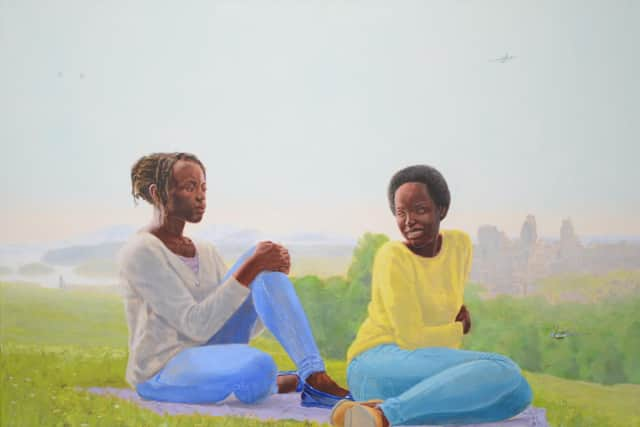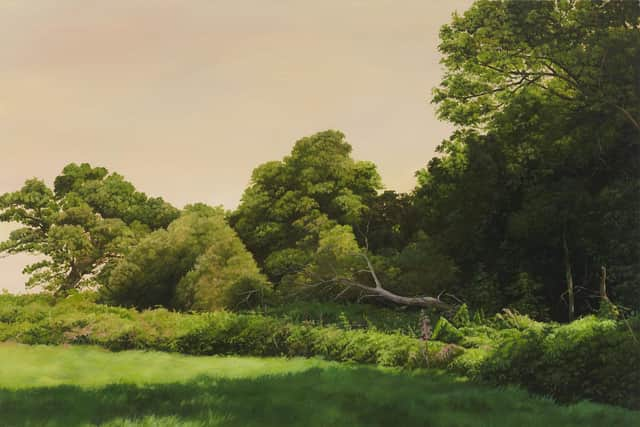New exhibition in Leeds challenges preconceptions about landscape painting
Our perception of landscape painting has mostly been shaped by the work of 19th and 20th century artists and the show, Arcadia for All? Rethinking Landscape Painting Now, which opened last week at the University of Leeds’ Stanley & Audrey Burton Gallery, brings a fresh perspective through the work of over thirty contemporary artists. Among those whose work is featured in the show are Hurvin Anderson, Andrew Grassie, Lubaina Himid, Matthew Krishanu, Elizabeth Magill and George Shaw.
Co-curated by guest curators Dr Judith Tucker, a senior lecturer at the School of Design at the University of Leeds and Geraint Evans of Camberwell College of Arts in London, the exhibition poses pertinent questions about who has access to nature, where and how, and addresses urgent contemporary issues such as climate crisis and our relationship with nature in a post-colonial and capitalist era. It also acknowledges that in the 21st century people experience landscape in many different ways – it could be through walking in parks, along public footpaths, working on allotments or in community gardens – even on a computer screen, exploring landscapes online or through gaming.
Advertisement
Hide AdAdvertisement
Hide Ad“At a time of serious ecological crisis when pollution and unsustainable ocean and land use are threatening both ecosystems and human existence, the exhibition feels more relevant than ever,” says Laura Claveria, the gallery’s exhibitions curator. “And we hope that the show will encourage people to think differently about landscape painting and its relevance to our times.”


The diversity of the 33 artworks on display and the variety of approaches to the notion of landscape – from playful to radical and political – makes it a very rich, thought-provoking exhibition. The range of artists from the well-known and established, to lesser known and emerging, emphasises the fact that concerns around access, identity, ownership and power in relation to landscape are cross-generational.
“Because Judith and Geraint are both lecturers and artists themselves, they have a very wide network and know many practitioners working within contemporary landscape painting,” says Claveria. “That is reflected in the broad spectrum of artists represented in the exhibition. The majority of the artists whose work features were born in the 1960s and 70s so in a way the show also pays homage to that generation of artists, but for Judith and Geraint it was important to represent and support younger, emerging artists too.”
The style of painting is varied with examples of figurative, abstract and experimental approaches. “Some of the works look at the connection between landscape and power, seeking out the hidden stories of who it belongs to,” says Claveria. “In the 18th and 19th centuries, it was associated with white landowners. Some of the contemporary artists place black figures in the landscape and others reference working class narratives and the marks of industry on the landscape.”
Advertisement
Hide AdAdvertisement
Hide AdRecent history is referenced with one very evocative painting of a taped over bench in a park dating back to lockdown when sitting on park benches was prohibited. “I think at that time we realised how much we need nature in our lives and for a lot of people their relationship to the landscape changed,” says Claveria. “ And there are lots of works in the exhibition that refer to the fragility of the landscape due to human behaviour – and capitalism.”


Overall the exhibition highlights and celebrates the vitality and variety of contemporary landscape painting. “I hope visitors will be surprised by that,” says Claveria. “Some people may think landscape painting is part of the past but it is very vibrant – we would like people to feel re-invigorated by the show. It deals with lots of meaty topics but it is also very beautiful and it invites people to be mindful both while they are in the exhibition and when they are in nature.”
At the Stanley & Audrey Burton Gallery, University of Leeds until July 29. The exhibition is free and open to everyone. Details library.leeds.ac.uk/galleries